Read our most important findings.
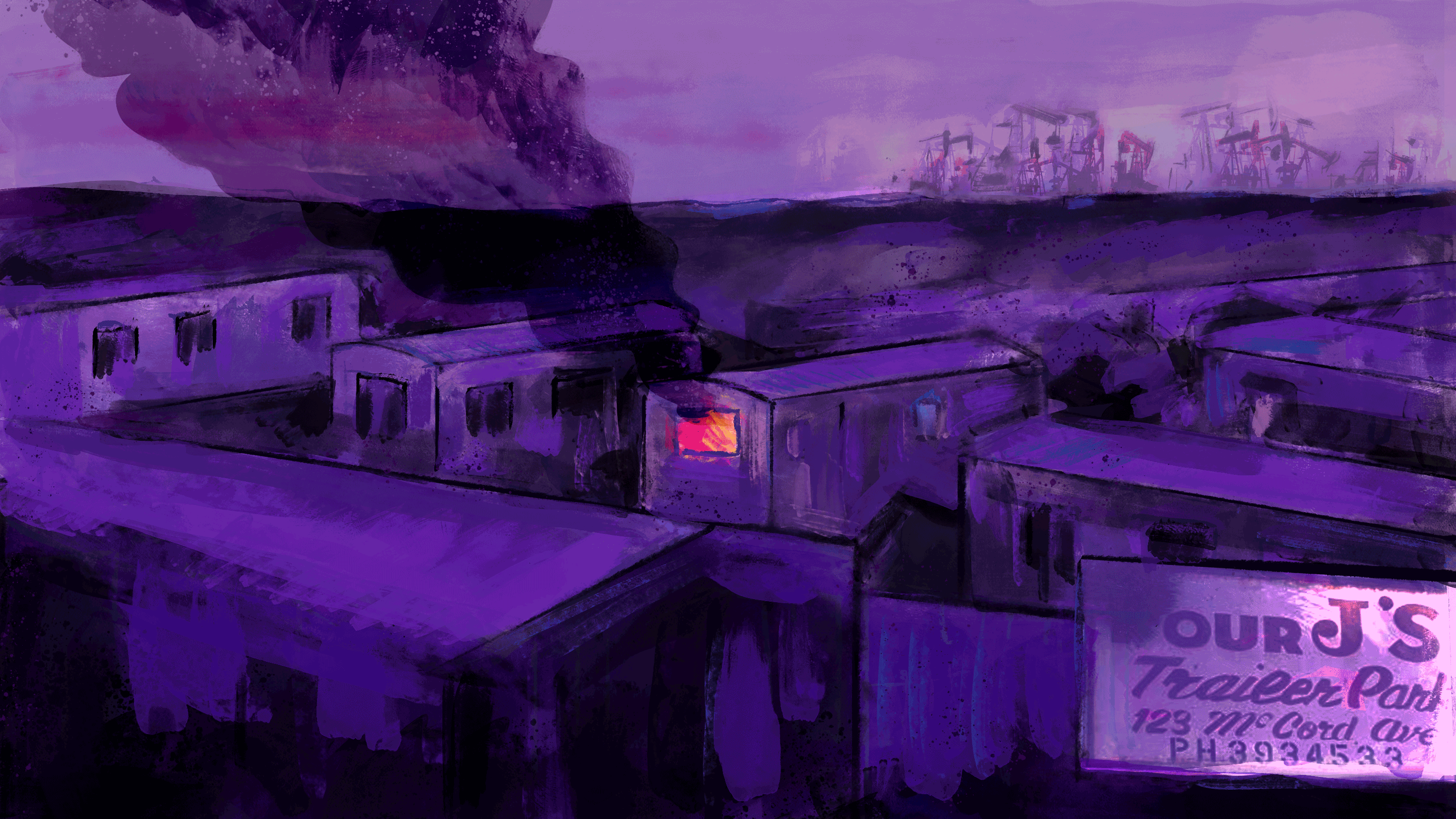
(Dan Carino for LAist)
NIGHTMARE IN OILDALE
The baby girl was in her crib when the fire broke out.
Ten feet away, in the living room of the mobile home, her young parents slept on the couch, in front of the TV. The baby’s father, Lorenzo Lozano, woke up first, minutes before midnight.
He and the baby’s mother, Marissa Rodriguez, had been living for 10 weeks at 4J’s Trailer Park in Oildale, a hardscrabble community just over the Kern River from Bakersfield. It was all they could afford, but the low price came with tradeoffs: exposed wiring, a leaky roof that required a tarp to protect against the rain, electrical outlets that sparked.
The night of Jan. 24, 2016, was cold, with temperatures dropping below 45. The heat in the mobile home wasn’t working; it hadn’t worked when the family moved in. Earlier that day, the lights were flickering and the internet was cutting out. Power had dimmed all over the mobile home park.
By nightfall, though, everything seemed to be working. Around 8:30 p.m., Rodriguez put 5-month-old Jenica to bed in her pink onesie, wrapping her up in blankets. Then she joined Lozano in the living room, and dozed off.
She woke up in an inferno, Lozano shaking her. She began coughing. She looked up and saw a wall of fire between her and her daughter.
Lozano ran toward the baby’s room to rescue Jenica, but it was too hot. The fire burned his head and back. All the couple could do was run outside and watch as the flames rose higher and engulfed the mobile home. A neighbor called 911, shouting:
“There’s a baby trapped in there. There’s a fire. It’s bad!”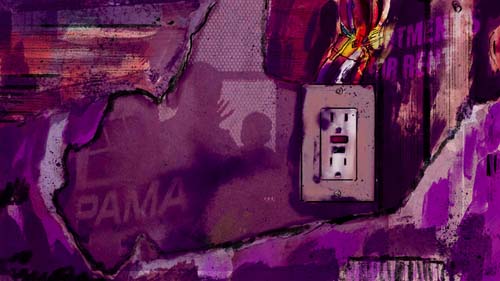
(Dan Carino for LAist)
‘DECADES OF NEGLECT’
4J’s Trailer Park belonged to a business named Cobra 28 No. 7, LP. It was run by another company, PAMA Management.
Both are connected to the same man: Mike Nijjar.
Virtually unknown to his tenants or the public, Nijjar is one of the biggest landlords in the state. Companies he is connected to make up a vast rental empire centered in some of the poorest parts of Southern California.
Nijjar himself lives in a Los Angeles suburb that Forbes Magazine once called “America’s Most Expensive ZIP Code.” His 12,000-square-foot hillside mansion, dubbed “Villa Bellefontaine,” sits in a gated community and boasts six bedrooms, nine bathrooms, a waterfall, a tennis court, a reflecting pool, a screening room and a vineyard.
ADVERTISEMENT
Many of Nijjar’s tenants live in starkly different conditions, fighting off roaches, rats, bedbugs, bees, maggots and mold, all while struggling to get even minor issues fixed. At many of these rentals, low-income residents feel stuck in unsanitary, dangerous housing.
The sprawling rental empire grew from modest beginnings in the 1970s into a behemoth. According to a KPCC/LAist analysis of government data and a review of public records, businesses connected to Nijjar account for at least:
an estimated 16,000 units spanning Los Angeles, San Bernardino, Riverside and Kern counties, and reaching Sacramento, Fresno and Arlington, Texas
$1.3 billion in real estate
4,400 parcels of land
4,300 eviction lockouts in Los Angeles and San Bernardino counties between 2010 and 2018
one in 20 evictions in San Bernardino County over the same time period
170 business entities, including corporations, limited partnerships and limited liability corporations
Tens of thousands of California’s poorest tenants — many just a step away from homelessness — have endured conditions in housing run by PAMA Management, which can be dirty, dilapidated and even deadly. That’s according to code enforcement documents, lawsuits and public data, as well as interviews with plaintiffs’ attorneys, fair-housing advocates, tenants and ex-employees.
Those sources point to alarming issues at properties run by Nijjar’s company.
At a Pomona trailer park owned by a Nijjar entity since 2005, typhus broke out in 2015. The medieval, flea-borne disease can kill if left untreated. Public health officials came in, trapping feral cats and opossums. On one opossum, they counted 1,087 fleas.
It was L.A. County’s first typhus outbreak since 2009.
Since the outbreak, the state has twice suspended PAMA Management’s permit to operate the Pomona park, citing electrical hazards and sewage leaks.
At another PAMA property, a manager testified that rats would swim in garbage water, walls would “bubble up” with mold and roaches “would fall over your body.”
At a third property, a lawsuit said a cockroach infestation was so severe that one of the insects climbed into a girl’s ear, requiring surgery for the bug to be removed.
At yet another complex, crime was so rampant that LAPD officers were afraid to patrol the property, leading the city attorney to file a lawsuit.
Nijjar declined to sit for an interview. Late last month, Cristina Ciminelli of the law firm Yukevich | Cavanaugh provided a statement to KPCC/LAist.
“PAMA Management cares about the communities and the people we serve. Providing affordable housing to those who need it is our mission. PAMA has operated in Southern California for more [than] 40 years. In its years of operation, PAMA has served tens of thousands of residents of Southern California.”
“Very often, PAMA assumes management of multi-unit apartment complexes in the community that are subject to City and County Code enforcement violations due to years of deferred maintenance, and does the necessary to improve those properties, clear the violations, and make it possible for families to continue to occupy those buildings.”
The unsigned statement does not mention Nijjar by name.
In testimony, Nijjar has aggressively defended the way he does business. “The tenant is very important to us, without them we wouldn’t be in business,” he said in a 2012 deposition.
In the same deposition, Nijjar characterized some renters as “crooked people” who are “looking for handouts.”
Regulators across California have excoriated the practices of Nijjar’s primary entity, PAMA Management. The city of Pomona criticized PAMA’s “long history of disregard and neglect for public health.” The California Department of Real Estate deemed PAMA’s actions “completely unacceptable.” The Los Angeles city attorney cited the company’s “decades of neglect.” And the Kern County district attorney called PAMA “a sophisticated slumlord.”
But for all the tough talk, regulators have rarely held PAMA accountable. Local enforcement, which can be fragmented and toothless, largely cites problems and imposes modest fines.
Governments also do not make basic information about landlords accessible, so renters, lacking key details, are left to piece together what they can from sites such as Yelp. As Gary Blasi, professor emeritus at UCLA School of Law, told KPCC/LAist, “If you compare the enforcement by the health department with restaurants, with their inspection of apartments, that’s a completely different world.”
While Californians can see the health score of a restaurant prominently displayed, there’s no letter grade in the window for apartments.
Search for properties connected to Mike Nijjar and PAMA in L.A., San Bernardino, Kern and Riverside counties. For more details, click on any colored parcel. Many parcels are located in poor areas.
Use the dropdown menu below to jump to an area on the map.
Source: KPCC/LAist analysis of county assessors’ data from Los Angeles, Kern, Riverside and San Bernardino counties; 2017 American Community Survey 5-Year Estimates. Median household income is for the census tract and is not specific to the parcel. Parcels in black have no median household income data available. This is not an exhaustive or up-to-the moment map of all PAMA-connected properties.
PAMA’s bottom line is also fed by unreturned security deposits, strictly enforced late fees and a system to efficiently evict tenants once they fall behind on rent, according to publicly available documents and testimony, as well as interviews with several people who have worked for the company.
Those practices make being a landlord in low-income areas lucrative. “A lot of landlords in poor neighborhoods aren’t making a living there,” said Princeton sociologist Matthew Desmond, who is also the author of Evicted: Poverty and Profit in the American City. “They’re making a killing.”

(Dan Carino for LAist)
DOWN AND OUT AT RIVER GLEN
Despite the pastoral name, there’s no burbling brook near the River Glen Apartments in San Bernardino. Instead, its three light-brown buildings sit between a sports bar and an empty lot. The hazy peaks of the San Bernardino Mountains loom in the distance as traffic flies by on the 210 freeway just a few hundred feet away.
Since 2003, the complex has been owned by entities connected to Nijjar — currently that’s Group XIV Properties, LP. PAMA manages the apartments. On a sunny Friday, tenants prepared to pay rent even as they struggled with issues they say PAMA refuses to address.
For Nancy Romero, the problem was bedbugs. Romero lives in a two-bedroom apartment with her three children, a roommate and her roommate’s daughter.
Her arms are covered in bites. She said she’s thrown out her bed and her couch, uses insecticide regularly and sleeps with the lights on.
But Romero can’t shake the pests. Moments into an interview, she opened a cupboard and brought out a glass container full of dead, reddish-brown bedbugs; she collects them to show the on-site manager how severe the problem is. But Romero said management hasn’t addressed the infestation, so she’s forced to send her children to school with bites on their arms.
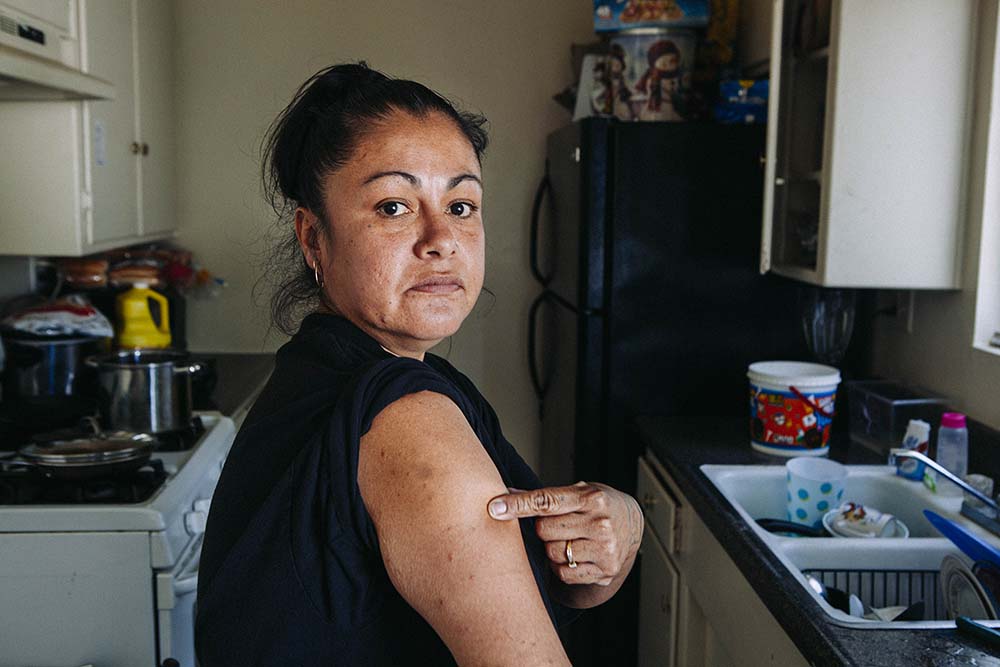

Nancy Romero points to her bedbug bites. She keeps dead insects in a container to show River Glen Apartments managers. (Chava Sanchez/LAist)
River Glen’s bedbug scourge is well documented: In 2018, San Bernardino city inspectors found infestations in each of the complex’s three buildings. “Entire property should be properly treated,” an inspection notice stated. But Romero said that PAMA can get away with ignoring the problem because tenants are desperate. “We low-income people, we don’t have the money to just say, ‘Come on, let’s pick up and go,’” she said. “So we go to our, you know, maintenance people, to our managers and stuff, and they don’t care. They don’t care.”
Still, Romero added, living with bedbugs at River Glen beats the alternative: “You don’t want your kids to be homeless.”
Romero isn’t being melodramatic. As Southern California’s housing crisis worsens, more and more people are winding up homeless — nearly 60,000 homeless people live in Los Angeles County alone.
The situation leaves low-income renters stuck in whatever housing they can find.
Blasi, the UCLA Law professor, has worked for years on behalf of low-income tenants. He summarized the current crisis this way: “I spent the first half of my career trying to get people out of slums, and the second half trying to get them back in.”
He said that when housing fails to meet basic standards, tenants can face serious health risks. Roach saliva and feces are known asthma triggers; rats and bedbugs can carry diseases; mold and mildew caused by leaky pipes can worsen respiratory problems; peeling paint can expose years-old lead, causing brain, kidney or nerve damage.
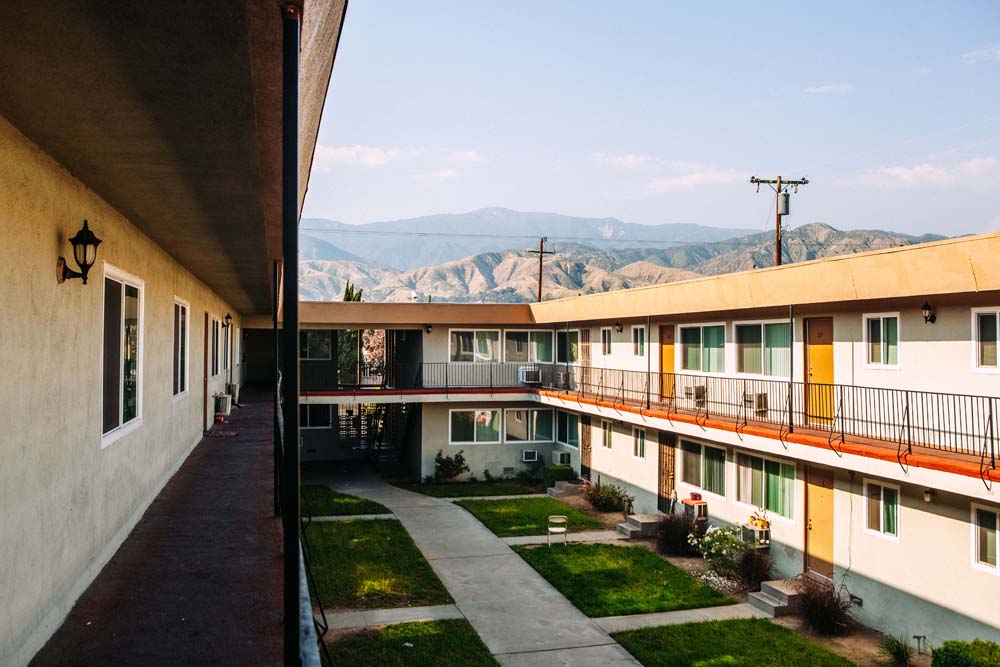
A courtyard at the River Glen Apartments in San Bernardino. (Chava Sanchez/LAist)
At River Glen, downstairs from Romero’s apartment, Vernon Moore was locked in a battle with mold. Twice a day, he said, he applies a concoction of bleach and the cleaning product Fabuloso in his bathroom; if he doesn’t, the mold creeps right back out.
Management rarely fixed his problems, the retired machinist said, “so I became my own maintenance man.” He’s seen property managers come and go — nine, by his count.
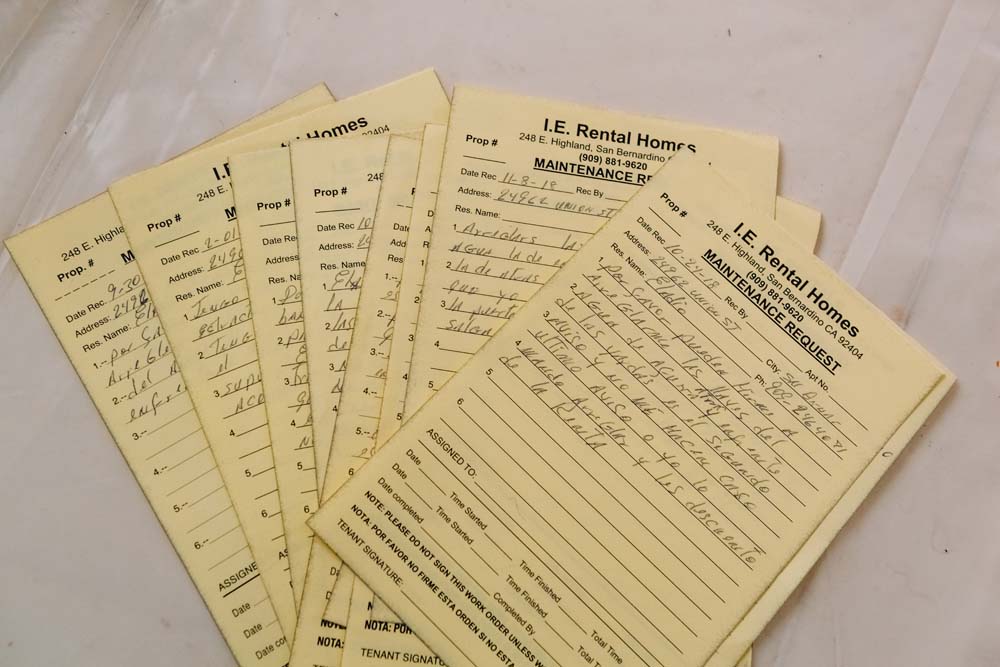
A year’s worth of maintenance requests for a house managed by I E Rental Homes, an entity within the Nijjar real estate empire. (Chava Sanchez/LAist)
Moore said he’s noticed something else: After code enforcement compels management to improve the building, the rent rises. “So the tenants is paying for they mistakes. Or the stuff that they not fixing,” Moore said, adding that his rent has jumped 20% in a little over three years, from $625 to $750.
The city of San Bernardino has known about problems at the complex for years.
A 2005 San Bernardino Sun story reported that city officials “identified PAMA as the worst landlord in town.” Documents from city inspections of River Glen detail maggots in the carpets, rats in the walls, a lack of hot water and “inadequate repairs.”
In 2016, the city took the unusual action of placing a $74,700 lien on one building at River Glen, citing long-standing, serious violations and the absence of a good-faith effort by PAMA to fix issues. The lien sparked an outcry from PAMA; three of the company’s senior staffers, joined by an attorney, spoke to the San Bernardino City Council during a closed session. City officials stood by the findings of persistent and severe code violations, but four months later, they reduced the lien to $50,000.
Another Nijjar business, I E Rental Homes, cut the check.
Even as PAMA fought the city, a legal complaint alleges that tenants at River Glen lived for stretches without hot water and electricity.
The statement PAMA’s attorneys provided to KPCC/LAist said, “Tenants with maintenance requests must report them to management. PAMA partners with maintenance professionals and contractors to maintain its properties. In addition, PAMA employs property managers who reside on the properties they manage with their families, and who have an interest in maintaining habitable living environments for residents.”
Former PAMA workers said in testimony and an interview that they have a name for shoddy repairs: “Mickey Mouse work.”
Issues at River Glen go beyond health and habitability; security has been a problem, too. As she prepared to put her 7-month-old down for a nap, renter Sherry Brown explained that some days, she keeps her children inside. “It’s that bad,” she said.
In September 2018, eight people were wounded in a shooting at the complex. After the incident, the city of San Bernardino issued a news release stating that PAMA Management was going to install locked gates and surveillance cameras, and hire a round-the-clock security guard. The Sun covered the changes: “Security guard Mark Underwood will be a towering, familiar presence at this San Bernardino, Calif., apartment complex where security has been increased to 24/7.”
Brown said she remembers the guard: “He was here for like two weeks, and walked around. Kind of felt safe, you know? And then he was gone.”
We don't have paywalls, but we do have payments (aka bills). So if you love independent, local journalism, join us.
In the wake of the shooting, then-mayoral candidate John Valdivia spoke to the Sun. Local property owners shouldn’t be “thrown under the bus,” Valdivia told the paper. “This is no fault of theirs.”
The same day the article was published, PAMA Management donated $1,000 to Valdivia’s campaign. City campaign finance records show that in 2017 and 2018, the company gave a total of $11,000 to support Valdivia, who was previously a city councilmember representing a district with dozens of PAMA properties. Senior PAMA staff members have privately met with Valdivia since he became mayor, city emails show.
A legal complaint filed by the former city manager of San Bernardino in 2019 alleged that “Valdivia tried to intercede on the company’s behalf, including about code enforcement efforts toward Pama following a shooting at one of its properties. Interestingly, Valdivia receives significant campaign contributions from Pama Management.” The city denied the claims.
Valdivia did not return calls or emails to his government and personal accounts seeking an interview.
Shootings have happened at several apartment complexes connected to Nijjar. At one PAMA-managed property a few miles from River Glen, on Arrowhead Avenue, bullet holes riddle the building and palm trees. A bullet even ripped through mailboxes, shredding tenants’ mail.
In a shooting at a nearby PAMA property, manager Donald Carter was struck by a bullet and blinded. Carter is the nephew of Vernon Moore, the River Glen tenant who battled mold. Later, Carter was called as a witness in an unrelated lawsuit, where he testified that PAMA evicted him, his wife and their six children while he was still in his hospital bed.
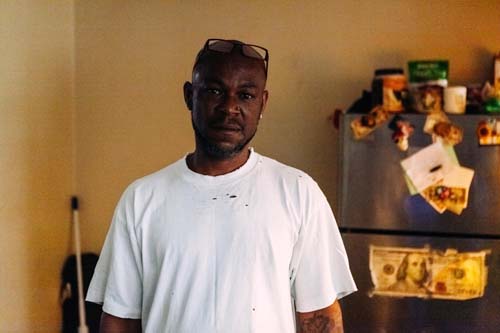
Vernon Moore stands in his kitchen at the River Glen Apartments. (Chava Sanchez/LAist)
The violence at River Glen, meanwhile, has continued. To check if visitors had guns, Moore said he would pat them down, under the guise of a friendly hug. On Oct. 17, 2019, a few months after speaking with KPCC/LAist, Moore was shot and killed in the parking lot of the River Glen complex. He was 51 years old.
Police don’t have a suspect.
OILDALE: ‘NON-SURVIVABLE’
Jan. 24, 2016 – Just before midnight
The 911 calls kept pouring in. The dispatchers grew concerned. “Is anyone inside?” one asked a caller. “It’s blazing bad,” the caller responded.
The first fire truck rolled into the trailer park before midnight, just minutes after the fire broke out. Two more engines were close behind.
Firefighters worked their way back to space nine. They found the mobile home completely engulfed in flames, and a blaze that had leapt to two nearby mobile homes. It was a “non-survivable atmosphere,” firefighters said. They were unable to attempt a rescue.
A sheriff’s deputy found Rodriguez, the mother of baby Jenica, outside the mobile home. She started crying, “My baby, my baby, my baby.”
Twenty-one members of the fire department responded to the blaze. One was an arson investigator, Captain Richard Turner. He could see the smoke pouring into the sky as he drove up. He interviewed Rodriguez. She was wearing her pajamas and flip-flops, a blanket over her for warmth. “I just saw fire and a lot of smoke,” Rodriguez said. But Turner had to stop the interview because Rodriguez started sobbing uncontrollably.
Firefighters doused the blaze with thousands of gallons of water. Finally, 23 minutes after midnight, they put it out.
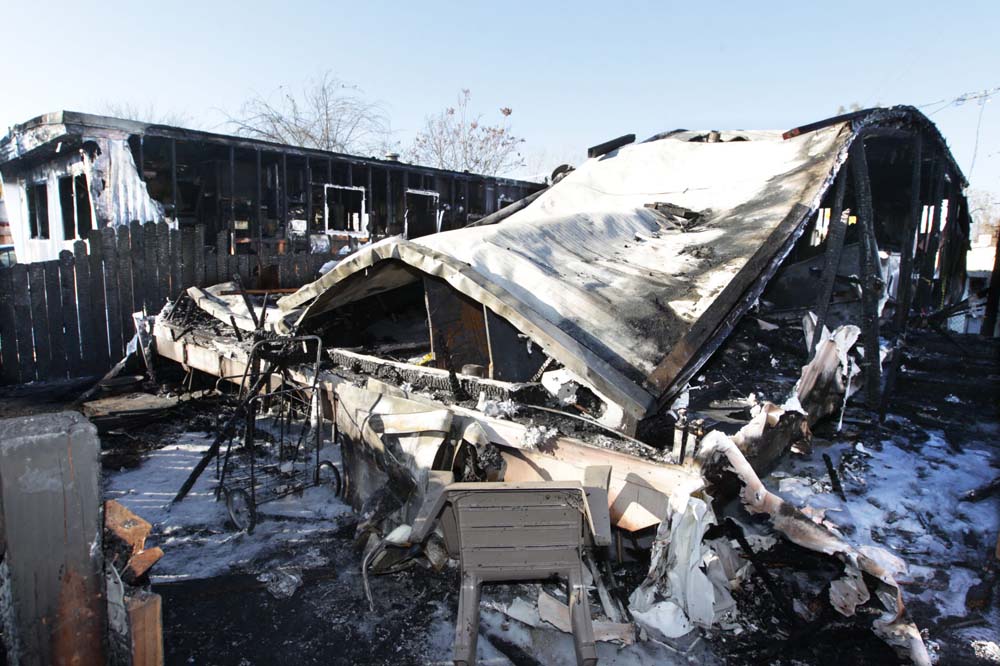
The burned remains of the mobile home where 5-month-old Jenica Okianna Lozano died in a 2016 fire. (Felix Adamo/The Bakersfield Californian)
Jenica Okianna Lozano died in her crib. An autopsy concluded that smoke inhalation killed her, likely within a few minutes of when the fire started. She was 5 months and 4 days old.
A deputy coroner found her wearing the remains of her pink onesie. Her baby teeth were just starting to come in.
LOW COSTS, HIGH MARGINS
Most properties connected to Nijjar sit in poor areas of their counties, according to an analysis of census data and parcel locations identified by KPCC/LAist.
In depositions and court documents KPCC/LAist reviewed, Nijjar does not explain his focus on “C and D” properties — real estate lingo for older buildings in low-income areas. Nijjar once graded a Riverside building his company owns as a “D minus.”
The final paragraph of PAMA's statement to KPCC/LAist says the company makes an effort "to create safe and affordable housing for low-income Southern California residents.
Interviews with housing and real estate experts offer another explanation for being a landlord to the poor: Low-income housing can offer higher margins.
Matthew Desmond, the Princeton sociologist, published a study last year on the business of renting to low-income tenants. His study showed that landlords earn substantially higher profits renting in poor areas than in richer ones. Desmond pointed to the lower operating costs and property tax bills in low-income areas. And while rents in poorer neighborhoods are lower, he said, they’re often “not significantly lower.”
The study determined that in Milwaukee’s poorest neighborhoods, profits could be double per month, per unit, compared with wealthier areas. The low-cost, high-profit model also proved true when the researchers looked at nationwide data.
ADVERTISEMENT
In 2017, longtime Los Angeles property manager Alec Bernstein examined several properties in the L.A. neighborhood of Baldwin Village. One of them was the 425-unit Chesapeake Apartments, which has been owned by entities connected to Nijjar since 1996.
Bernstein was there at the request of the Los Angeles City Attorney’s office, which was preparing to sue Nijjar and PAMA Management over safety concerns. As he walked around the complex, Bernstein grew alarmed. He observed it was “owned and operated in an astonishingly lax and deficient manner.” He wrote in a declaration filed in court that nearby, non-PAMA properties were “obviously operated in an infinitely better way.”
Bernstein continued: “I cannot recall ever seeing a property that is this size and value, owned and operated by persons or entities who have a very substantial financial profile, so starkly rundown, foreboding, and seemingly rudderless.”
The suit alleged PAMA’s property “has been plagued by rampant crime for decades” and that PAMA showed little interest in dealing with it. “Anyone who sets foot on or near the Property is at risk of becoming a crime victim,” the complaint said.
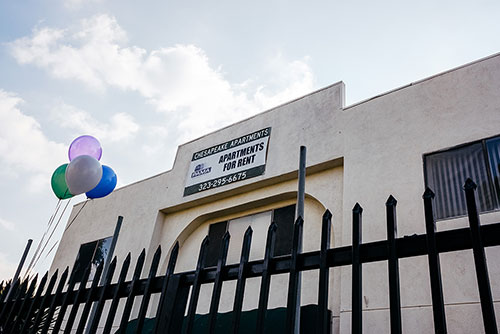
In 2017, the L.A. city attorney tried to force Mike Nijjar to live in the Chesapeake Apartments in L.A.’s Baldwin Village. (Chava Sanchez/LAist)
LAPD officers were afraid to visit the complex, according to the city attorney, and often patrolled in groups of eight.
The city attorney tried to force Nijjar to live at the property, and to strip PAMA of management duties.
PAMA’s attorneys strongly objected, and Judge James C. Chalfant swatted down the requests. Still, the judge was deeply concerned by the security issues, saying at a hearing, “I see no reason why the City and the police department should bear the fiscal cost…When the property owners are making in the neighborhood of four to five hundred thousand dollars a month in rent.”
But landlords renting in low-income areas don’t need to skimp on maintenance to make a profit, Bernstein said in an interview. “If your neighbor has a great property,” he asked, “Why isn’t yours? It’s a lack of will, a lack of management, a lack of understanding.”
The case settled. PAMA denied liability, but pledged to add security guards and locks, and to provide four free loads of laundry per month and $50 Albertsons gift cards — one per unit — to tenants.
Because Nijjar declined to talk for this article, and because the inner workings of his businesses are closely held, legal proceedings provide a rare window into the man and his real estate empire.
In a 2002 case, the Housing Rights Center, a nonprofit advocacy group, alleged PAMA discriminated against families with children at a South El Monte complex. The complaint quoted a letter from PAMA executive Everet Miller:
“We will issue a $50 per month rent increase to tenants who have children playing on the property. We will not accept excuses about summer, work, etc., the children can go elsewhere to play.”
The case settled in 2006.
Another suit, from 2010, followed a bicycle crash at a PAMA-run trailer park in Yucaipa, where a 3-year-old fell off an unfenced cliff and suffered a severe head and brain injury. A jury found PAMA Management and another of Nijjar’s companies, Nijjar Realty, were negligent; they had to pay more than $1.2 million to the girl’s family.
A third suit was filed by employees in 2018 over unpaid wages, alleging Nijjar and his family “have reaped millions of dollars of profits from this wrongful and illegal business model.” Nijjar, his family and business partners denied the claims. The case is still pending.
A legal saga that started in 2011 went into remarkable detail.
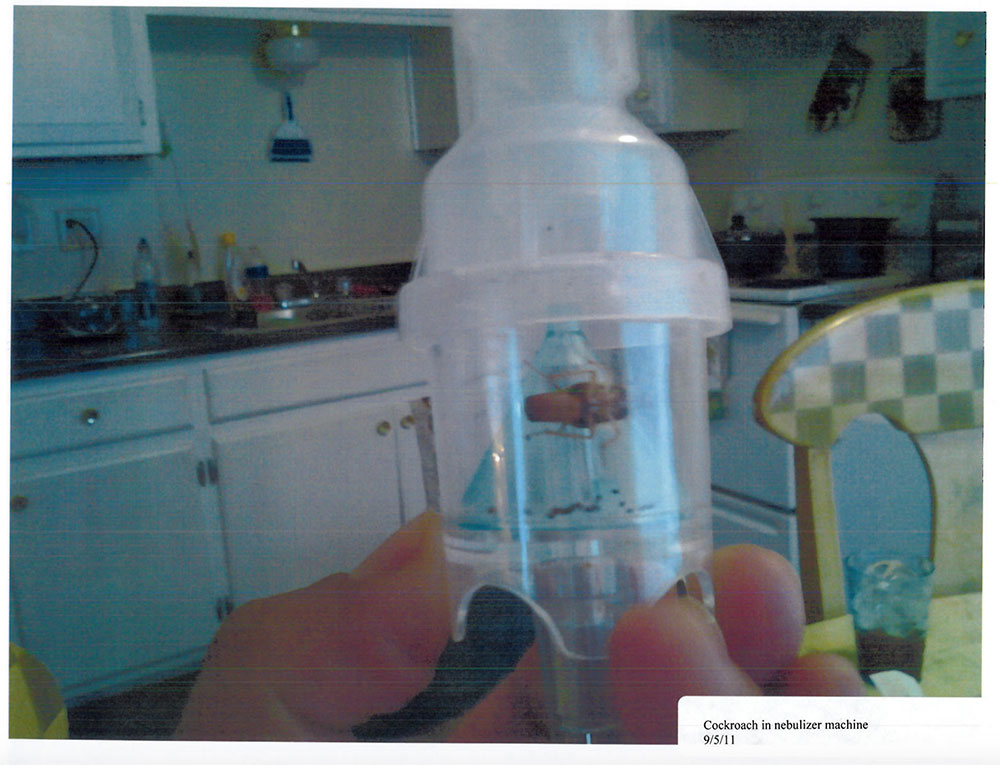
A photo, from court records, of a cockroach inside a nebulizer belonging to a PAMA tenant’s daughter.
Source: Superior Court of State of California, Riverside County
It began with three attempts by PAMA to evict the Jimenez family from their Riverside apartment. The third went to trial. One of the defendants, Tiffany Jimenez, said in a court declaration that cockroaches would fall from the ceiling into food as she was cooking, and that she could feel roaches crawling on her body at night. Water leaks, dripping down from the unit upstairs, worsened the roach issues, the family’s attorney alleged.
One photograph presented at trial showed a cockroach that had crawled inside the nebulizer of Jimenez’s young daughter, who had asthma.
The jury deliberated for less than an hour before unanimously siding with the Jimenez family. Jurors determined the fair rental value of the unit was zero dollars, and ordered PAMA to fix the electrical, plumbing and roach problems.
After winning their eviction fight in court, the Jimenez family filed a suit over the conditions at their apartment.
In a video from his deposition for that case, Mike Nijjar expressed little emotion beyond boredom and mild irritation. But at times, his disinterest turned to fury.
At one point, Nijjar yelled, “You have done enough fishing expeditions. You manufactured this stupid lawsuit.”
“How?” the plaintiffs’ lawyer asked.
Nijjar thundered back, “You put those roaches in those places! You paid these people to come in and testify!”
He later told the attorney: “Don’t play smart with me; it’s your house that probably has roaches.”
During the deposition, Nijjar pounded the table. He said the claims he faces in lawsuits are ginned up. “If you have crooked people living in apartments with criminal activities who are looking for handouts, yeah, there are a lot of people that can testify against PAMA.”
Nijjar and PAMA have a reputation for fighting hard and using every legal tool available. Lawyers representing tenants say attorneys for Nijjar and the people he works with are skilled, expensive and unrelenting.
Grant Riley has been filing what he calls “slum housing” cases for a decade. “Look, Mike Nijjar and his sister Daljit Kler are very tough customers,” he said. “They own a lot of apartments, they are rough-and-tumble apartment owners. And they take a very aggressive stance when they get sued.”
Riley wrote in one legal declaration that PAMA’s attorneys “made this case impossibly difficult and expensive to litigate.” Nijjar and PAMA, he wrote, “refused all efforts to settle and had an unlimited amount of funds available to litigate the case.”
In practice, that means hundreds of written questions, burdensome requests for documentation, and “incomplete or evasive” discovery responses, according to April Blackman, another attorney who has represented tenants in suits against PAMA.
“My experience with PAMA is that they do fight hard. And they deny, and they blame,” Blackman said. “They just seem to be impervious to our laws.”
Companies connected to Nijjar don’t just get sued, they also go on the offensive. Following a 2005 fire, Pete Nijjar — Mike’s brother and former business partner — sued Nijjar Realty’s insurance company. A judge ruled the case was meritless, but not before the proceedings led to the disclosure of the insurance policy.
According to that policy, dated July 2004, Nijjar Realty was insuring 415 properties that generated an income of $78 million in today’s dollars. Today, companies connected to Nijjar own thousands more properties.

(Dan Carino for LAist)
NIJJAR’S PATH TO PAMA
In 1966, Swaranjit Nijjar arrived on the campus of Yuba College in rural northern California. He’d just moved from India, and while in school he also picked peaches on his aunt’s farm. The work didn’t take. “I was too scared to pick peaches,” he would later say, so he wanted “to get away.”
Although Nijjar declined interview requests, he shared his personal story in a 2011 deposition. Leaving Yuba College and the peach farm, he headed 300 miles south to San Luis Obispo. There, he earned his bachelor’s degree in industrial engineering at California Polytechnic State University, working at a McDonald’s on the side.
As a young man, he took a series of odd jobs, none in real estate. He drove 70-foot trucks for the oil giant Halliburton, he testified, crashing multiple times before being let go. He settled in the L.A. area and bounced from employer to employer: a food company, a tool company, SoCal Edison.
It wasn’t until the mid-1970s that Nijjar entered real estate. He worked for a broker, placing classified ads in the Los Angeles Times. By that time, Nijjar was using the nickname, Mike. In 1978, he obtained his own real estate broker’s license.
In the same deposition, an attorney asked Nijjar why he decided to get licensed. Nijjar paused for 12 full seconds, gazed around the room and cracked a smile: “I don’t know, [to] be frank with you.”
But he stuck with it. In 1979, he filed articles of incorporation for his own company, Nijjar Realty. Nijjar has testified that he owned 80% of the business at the time. The rest was split by his friend Sad Chadha, and his brother, Paramjit ‘Pama’ Nijjar.
In a 2012 deposition, Nijjar said that’s where he got the company name. A PAMA Management website, no longer live but available on internet archives, described PAMA as an acronym for Prosperity Aspire Motivation Achievement.
In the early years, Nijjar Realty mainly sold real estate, but by 1986 the company expanded to include property management services.
A real estate recession in 1993 brought Nijjar together with his business partner for the next quarter-century: Everet Miller. The Southern California native sold edible oils and fats for Proctor & Gamble, and in the 1980s and ’90s worked for several financial institutions, according to depositions.
“Mike just needed some help with a couple parts of the operation,” Miller testified years later, noting that when they joined forces, Nijjar had been seeking guidance on setting and raising rents. (The comment PAMA’s attorney sent KPCC/LAist was also on behalf of Miller.)
By the mid-1990s, PAMA advertised “over 200 locations in the San Gabriel Valley.” But the company’s biggest break came with the housing crisis in 2008, when a glut of homes and apartment buildings became available at fire sale prices. PAMA began a dramatic expansion.
Nijjar and Miller were part of a nationwide transformation in the rental market as big corporations bought up thousands of properties, muscling aside mom-and-pop landlords.
Through an expanding armada of entities, Nijjar began gobbling up real estate all over Southern California, property records show. He pushed into areas decimated by the crisis, including the Inland Empire, the Antelope Valley and, more recently, Kern County.
Since the late 1970s, companies owned by and connected to Mike Nijjar have been acquiring properties in Los Angeles County.

In the mid-2000s, the business began moving east, initially into San Bernardino County.
The growing real estate empire then snapped up hundreds of parcels at fire sale prices when the Great Recession hit the Inland Empire.

In Riverside County in the last 15 years, entities connected to Nijjar bought more than 1,000 parcels.

More than 80% of the parcels currently connected to PAMA and Nijjar located in L.A., San Bernardino and Riverside counties were acquired after 2008.

Source: KPCC/LAist analysis of county assessors' data from Los Angeles, Riverside and San Bernardino counties
NOTE: Years reflect the "base year" of a given property, generally when a change in ownership last occurred.
In a recent job posting, PAMA and Nijjar Realty said they had about 500 employees. The ad boasted that PAMA was “one of the first movers in [the] nation to buy Single Family Rentals,” purchasing 3,000 of them in 2015. The job posting also stated that PAMA owns and manages more than 18,000 units. (KPCC/LAist’s analysis of property records estimates entities connected to Nijjar own approximately 16,000 units in Los Angeles, San Bernardino, Riverside, Sacramento and Kern counties, and in Tarrant County, Texas.)
Nijjar does not own rental properties in his own name, Miller has testified. Instead, his and his family’s holdings are spread across a constellation of more than 170 business entities — a mix of corporations, limited partnerships and limited liability corporations, according to a KPCC/LAist analysis of data from the California Secretary of State. The entities have names like Iceberg Investments, Starlight Management 17 and Golden Opportunity No. 14.
Nijjar testified in 2019 that he is the majority shareholder of PAMA Management, Inc. Properties connected to Nijjar are generally centered around a limited partnership. Typically, the entities don’t do much, Miller testified in 2018: They’re formed to hold title, and have no actual employees. He said a corporation often serves as the general partner, owning a small share; a Nijjar family trust owns the rest, up to 99%.
Having multiple entities under one umbrella can help shield stakeholders from liability in the event of a lawsuit. Many real estate businesses utilize dozens of entities, often shrouding the ownership of property.
The Nijjar businesses that own property often contract with PAMA for property management services, such as rent collection and repairs, according to public documents and depositions KPCC/LAist reviewed. (Many of the single family homes have been managed by another entity connected to Nijjar, I E Rental Homes.) In other words, Mike Nijjar effectively contracts with Mike Nijjar.
For decades, he has also owned an El Monte hardware store where PAMA maintenance workers buy supplies. The sales add up: In 2011, maintenance workers spent up to $300,000 per month at the store, according to testimony from its longtime manager. (The manager, Nijjar’s then-brother-in-law, added that Mike Nijjar had never set foot inside.)
ADVERTISEMENT
Nijjar also decides which apartments and homes to purchase. According to his testimony, he has driven to a property he’s considering buying and made his decision from the car.
Yet, he’s hands-off about many aspects of the business. He rarely involves himself in hiring or firing decisions, Miller said in a 2018 hearing. But he has elevated family members into important roles.
His youngest son, Michael Preet Nijjar, runs the arm of the business that provides laundry services at PAMA-managed properties. Michael Preet is being groomed to take over the company, Miller testified in 2018. The younger Nijjar is also a “proud member” of the Vegas Golden Knights ownership group, according to the National Hockey League’s website. (The comment PAMA’s attorney sent KPCC/LAist was also on behalf of Preet.)
And Nijjar has delegated property management duties to his sister, Daljit Kler, who, like other Nijjar family members, did not respond to a request for comment. “She has 100% control,” he once testified. “She doesn’t need my permission.” Kler is eight years younger than her brother, but they have decades of shared experiences — she also picked peaches.
OILDALE: ‘TOTAL DISREGARD FOR THE LAW’
While Rodriguez and Lozano were grieving the death of their 5-month-old daughter, Turner, the arson investigator, set about trying to determine what caused the blaze. It wasn’t easy. Firefighters were still extinguishing hotspots in the cold night air.
Turner approached the mobile home and walked around it, clockwise. He saw the unit had sustained heavy fire damage. A wall had collapsed.
He entered and stepped through the kitchen, into the bedroom. “Everything was kind of just a melted blob,” he would later say in court, referring to the wiring and the breaker panel in the bedroom. He found a metal box that looked like a space heater.
He did not find a smoke detector, which is required, by law, in bedrooms.
Turner also inspected the two neighboring residences that caught fire.
He didn’t find smoke detectors in those, either.
Turner concluded that the cause was either the space heater or an electrical problem. He did not find any misuse of the space heater.
The holes in the home’s roof may have allowed air to rush in and feed the fire.
In a report he wrote, “I believe that Pama Management Company has been negligent in their business operations.” Turner also requested charges against PAMA “for criminal neglect.”
This is the only case I'm aware of where the negligence of a real estate licensee was so severe that it led to the loss of human life. — James Demus
California Department of Real Estate attorney
Turner was not the first government regulator to visit 4J’s Trailer Park. Three weeks before the fire, a state housing inspector had dropped by the park. He was surprised to see people living in unlicensed mobile homes — as the inspector for the area, he should have been notified so he could review them before they were installed.
Yet there they were. The inspector, Robert Martinez, served PAMA with a written notice that seven mobile homes, including the one where baby Jenica would die, were not permitted for human occupancy. He also found an imminent electrical hazard at one mobile home. PAMA was ordered to fix the problems.
In the wake of the fire, PAMA claimed it had complied with the order; a judge called PAMA’s claim “uncorroborated.”
After the fire, regulators from the California Department of Real Estate took a harder look. The property was owned by Cobra 28 No. 7, LP and was managed by Nijjar Realty, which was doing business as PAMA Management. The company had not secured a permit to install the mobile home in space No. 9; it was not legally allowed to rent out the trailer where Jenica died.
Rodriguez and Lozano, just 16 and 17 years old at the time, had been desperate for a place to live. So Rodriguez's older sister, Angelica Rodriguez, signed the lease — at least, she told investigators she thought she was signing rental documents.
In fact, she signed “rent to own” paperwork and was buying the mobile home for $10,000, at an interest rate of 10%, more than double the going rate for a typical home loan at the time.
Even if Angelica made every payment on time, it would take years to pay off a mobile home that was in terrible shape. She was also on the hook to pay another $325 per month: rent for the space the mobile home sat on.
State regulators determined that Nijjar Realty broke real estate law in several ways: The sales agent they’d used was unlicensed. The mobile home had not been installed by a licensed contractor. The company did not use a licensed escrow company. And they failed to provide Angelica with title or registration.
The investigator’s report was blunt: Nijjar Realty “owed the buyers every consumer protection outlined in the law.” Instead, PAMA’s unlicensed agent sold mobile homes “in dilapidated condition” without basic disclosures.
We don't have paywalls, but we do have payments (aka bills). So if you love independent, local journalism, join us.
The unit also had no carbon monoxide detectors, as required by law.
PAMA, the state investigator concluded, showed “a total disregard for the law.”
A Department of Real Estate attorney reached a similar conclusion, writing in a court filing that “from the standpoint of a real estate licensing, it was also a deceitful suppression of information that it was the licensees’ duty to disclose.” The attorney added that “complete disregard for all Health and Safety Code statutes and regulations that are intended to protect the public led to the death of an infant. That conduct alone is unacceptable for any real estate licensee.”
In an interview with KPCC/LAist, Department of Real Estate attorney James Demus said, “This is the only case I’m aware of where the negligence of a real estate licensee was so severe that it led to the loss of human life.”

(Dan Carino for LAist)
EMPIRE OF FEES AND EVICTIONS
While tenants allege and regulators say that PAMA is lax about maintenance, the company is ruthlessly efficient about collecting rent and piling on fees. That’s according to legal testimony and former PAMA employees who spoke with KPCC/LAist.
Withholding security deposits, in particular, can be lucrative. Financial statements show that at PAMA, this particular revenue stream is known as “earned security deposits.”
“I cannot recall anybody getting the full deposit back at all, when I worked there for a year and a half,” said a former PAMA leasing agent who asked that his name be withheld for fear his career could be damaged.
Former PAMA employee Breanna Cook answered phones in the Yucaipa area. “I would get calls from people saying, you know, they’ve been trying to get ahold of somebody for years, just to get their deposit back,” she recalled.
During the Jimenez family’s lawsuit, PAMA produced a financial statement covering five years at a 34-unit property in Riverside. In one year, the statement shows that zero dollars in security deposits were returned to tenants, while PAMA retained $13,100 in deposits, or 5% of income from the property.
The same financial statement points to another source of income: $50 late fees, written into leases and often underlined for emphasis. (Despite the substantial number of Spanish-speaking people who rent from PAMA, and a state law that requires a lease negotiated in Spanish must be provided in Spanish, the company's leases are only offered in English, according to testimony given by Kler, Nijjar's sister.)
For tenants living at the bottom rung of the socioeconomic ladder, these fees can be crippling. “Fifty dollars is make or break in terms of feeding their family,” said Riley, the attorney who sued PAMA in the case that produced the financial statement.
Many of our tenants live literally paycheck to paycheck; it doesn't take much to push them over the edge. — Everet Miller
Mike Nijjar’s longtime business associate at PAMA
The document indicates that in most years, late fees brought in a few thousand extra dollars from just the 34 rental units at the Riverside property; across the estimated 16,000 units, late fees could add up to more than a million dollars per year.
Another lawsuit, filed in Los Angeles County in 2012, alleged that a single late fee can set into motion a cascading series of charges. In the complaint, plaintiff’s attorney John Mittelman wrote, “Even if a tenant pays the February rent on time, the $50 late fee [for January]… is deducted first,” meaning the tenant remains $50 behind. So, Mittelman said, tenants could be hit with another late fee in February, sometimes without their knowledge. Those unpaid fees could lead to an eviction, he said, completing “a pernicious and ugly cycle.”
Tenants at the bottom of the rental market often have to decide between paying rent on time and how much food they can put on the table. Here's a look at how a seemingly small penalty can wreak financial havoc, and eventually lead to eviction.
PAMA’s eviction machine churns through Southern California.
Companies connected to Nijjar have locked out tenants more than 4,300 times since 2010 in Los Angeles and San Bernardino counties, and are behind one in 20 of all lockouts in San Bernardino County in the past decade, according to data from county sheriffs’ departments.
Some tenants in properties connected to Nijjar say eviction notices are so common that they blend into the background. One Pomona renter said she spotted a notice on the door of a neighbor who had recently died.
PAMA Management handbooks for employees reviewed by KPCC/LAist included an eviction calendar, showing when to file, and an eviction flowchart, laying out the process.
PAMA contracts with outside eviction services companies. In 2012, PAMA used several firms to file for approximately 140 evictions per month, Miller testified.
One of the firms, Fast Eviction Services, advertises a promotion for companies that feed them business: designer purses for new eviction cases.

Source: Fast Eviction Services
While landlords have the right to evict tenants who can’t pay rent or break the terms of their lease, a growing body of research details the long-lasting effects of eviction on families and communities. Fast and frequent eviction “starts to tear away at the fabric of cohesion in a neighborhood,” said Lavar C. Edmonds of Princeton’s Eviction Lab, which studies how evictions impact communities. Lockouts can traumatize children and lead to job loss and depression among adults.
Evictions are often seen as the result of poverty, but researchers such as Edmonds say eviction itself causes and worsens poverty. With a red mark on their rental history, tenants often have an extremely difficult time finding housing.
That’s true at PAMA Management. Former PAMA staffer Albert Moran told KPCC/LAist that for prospective tenants, “As long as they didn’t have an eviction [on their record], then they were good to go.”
PAMA is aware of how high the stakes are for renters facing eviction.
“Many of our tenants live literally paycheck to paycheck; it doesn’t take much to push them over the edge,” Nijjar’s partner, Miller, testified in 2011. Still, he said, “We can’t be aggressive and send out Guido with a baseball bat and break their kneecaps. The system is the system."
Advocates and attorneys also said PAMA uses evictions to retaliate for complaints about living conditions and maintenance.
“Tenants are afraid to pick up the phone because of the retaliation. Because they’re going to end up being on the street, being evicted, for voicing a concern,” said Elizabeth Signorelli of the nonprofit Fair Housing Council of Riverside County.
Because the vast majority of buildings connected to Nijjar are in areas without rent control, his companies have had wide latitude to set and raise rents on a whim. “They also retaliate by increasing the rent,” Signorelli said. “That will get [the tenants] out — that will teach them a lesson for asking for repairs.”
Miller has testified that rent hikes are not retaliatory. Instead, he said, “It’s kind of subjective.” He said he considers market conditions, how long a tenant has lived there and the date of the last increase. “If I hadn’t raised their rent in a year, I probably give them a rent increase.”
OILDALE: CRACKING DOWN
After the fire that killed baby Jenica, government agencies attempted to hold Nijjar and PAMA Management accountable.
California’s Department of Real Estate, drawing on an investigation by Housing and Community Development, moved to revoke the real estate licenses of Nijjar Realty, PAMA Management, Mike Nijjar, his sister Daljit Kler and Everet Miller.
The agency’s lawyer filed an accusation that hinged on the intricacies of real estate law and licensing.
It noted that while Mike Nijjar had been the “designated officer” of Nijjar Realty for 35 years, he had relinquished the title to his longtime associate, Everet Miller, two years before the fire. Still, the state’s legal filing identified Nijjar as the “owner, holder of all corporate offices, and sole director” of Nijjar Realty.
Nijjar and Kler “refused” to appear for a hearing, the state attorney wrote, even after she requested their presence.
Everet Miller did appear. He was the designated officer, meaning he was responsible for ensuring the company followed real estate laws and regulations. After three days of hearings, the judge revoked Miller’s real estate license and stripped the license of Nijjar Realty, Inc. Miller and the company are fighting the decision; a hearing is set for April. (Licensees can also go through a “rehabilitation” process through the Department of Real Estate.)
A judge allowed Mike Nijjar to keep his license.
ADVERTISEMENT
There was another attempt at enforcement following baby Jenica’s death. The Kern County district attorney’s office investigated, reviewing a folder of rental housing locations and violations connected to PAMA. According to a case report, the agency considered a murder charge against PAMA Management.
Ultimately, the district attorney charged the company in 2018 with involuntary manslaughter. The documents do not name Nijjar, Miller or any other individual.
In a preliminary hearing in Bakersfield, an attorney for PAMA argued it was unclear who even owned the mobile home park, citing a “glaring lack of evidence.”
Deputy District Attorney Nicholas Lackie fired back: “A sophisticated slumlord draws up a complicated corporate structure to shield itself from liability causing the death of a newborn baby.”
But his argument did not prevail. The judge said there wasn’t enough evidence presented to move forward with the charge, and the case was dismissed.
The criminal charges that arson investigator Richard Turner had requested did not make it to trial.
‘HOW COME THE CITY HASN'T PUT ME IN JAIL?’
I
n 2011, while being sued for conditions at one of his Riverside County apartment complexes, Nijjar defended his business practices. If that property was so bad, he asked, “How come the other people living there? How come the city hasn't come put me in jail?”
Here are a few possible answers.
First, enforcement is fragmented. Mobile home parks, for example, are regulated by the state. But apartments are monitored by cities and counties. That means a trailer park and an apartment complex can sit side by side but can be regulated by different agencies.
Further complicating matters, different departments regulate different aspects of a building: In Los Angeles, the Department of Building Services permits work on roofs and plumbing; a housing department program checks on compliance with building codes; and the fire department inspects for fire code violations.
Even when inspectors visit, they may miss serious problems: For example, city officials inspected a Koreatown building — not owned by Nijjar — in 2008, leading to no follow-up actions. The next year, that building collapsed, injuring four people.
Many rental inspections are reactive; they don’t happen until a tenant complains, but some tenants don’t complain for fear of retaliation. And even strong regulations can lack adequate enforcement in cash-squeezed jurisdictions.
When regulators do act, they generally focus on one property at a time, rarely stepping back to assess all the properties a landlord owns, to look for patterns. They may not even be aware of the web of connected entities that make up a modern real estate empire.
I could own 1,000 properties in L.A., but they could be under 1,000 different LLC names or shell companies. There just needs to be a lot more light and transparency on the question of who's owning our cities. — Matthew Desmond
Princeton University sociologist
We found more than 170 corporations, limited partnerships and limited liability companies connected to Mike Nijjar, his family and associates.
| Entity | Started | Type |
|---|---|---|
| NIJJAR REALTY INC. | 1979 | Corp. |
| MAX'S HARDWARE, INC. | 1981 | Corp. |
| MALLORCA APARTMENTS, LTD. | 1984 | LP |
| SIOUEIROS LIMITED PARTNERSHIP | 1984 | LP |
| SSM INVESTMENTS, INC. | 1985 | Corp. |
| GROUP I EL MONTE, INC. | 1993 | Corp. |
| GROUP II AZUSA, INC. | 1993 | Corp. |
| GROUP IV POMONA, INC. | 1993 | Corp. |
| SAN GABRIEL PROPERTIES, INC. | 1993 | Corp. |
| GROUP I EL MONTE PROPERTIES, LTD., A CALIFORNIA LIMITED PARTNERSHIP | 1993 | LP |
| GROUP II AZUSA PROPERTIES, LTD., A CALIFORNIA LIMITED PARTNERSHIP | 1993 | LP |
| GROUP III SGV PROPERTIES, LTD, A CALIFORNIA LIMITED PARTNERSHIP | 1993 | LP |
| GROUP IV POMONA PROPERTIES, LTD., A CALIFORNIA LIMITED PARTNERSHIP | 1993 | LP |
| 012-015 APTS, LLC, THE | 1997 | LLC |
| MP OPPORTUNITY PARTNERS I, LLC | 1997 | LP |
| MAX'S HARDWARE, LLC | 1998 | LLC |
| 460 RANCHO MHP, A CALIFORNIA LIMITED PARTNERSHIP, THE | 2001 | LP |
| S & R VENTURE I, LLC | 2001 | LP |
| STARLIGHT MANAGEMENT 17, INC. | 2002 | Corp. |
| COBRA-28 LIMITED PARTNERSHIP | 2003 | LP |
| MOBILE HOME GROUP I, LP | 2003 | LP |
| MPN-14 LIMITED PARTNERSHIP | 2003 | LP |
| STARLIGHT MGMT-17 LP | 2003 | LP |
| GROUP V SAN BERNARDINO, INC. | 2004 | Corp. |
| ROPAIN LAUNDRY SERVICES, INC. | 2004 | Corp. |
| GROUP V SAN BERNARDINO, LP | 2004 | LP |
| COBRA-28, INC. | 2005 | Corp. |
| GROUP VII FRESNO PROPERTY, INC. | 2005 | Corp. |
| MOBILE HOME GROUP III, INC. | 2005 | Corp. |
| MPN-14 MANAGEMENT, INC. | 2005 | Corp. |
| THE 0312 RAMONA APTS., INC. | 2005 | Corp. |
| THE KINGSLEY APTS. 320, INC. | 2005 | Corp. |
| 0312 RAMONA APTS., LP, THE | 2005 | LP |
| GROUP VII FRESNO PROPERTY, LP | 2005 | LP |
| KINGSLEY APTS. 0320, LP, THE | 2005 | LP |
| MOBILE HOME GROUP II, LP | 2005 | LP |
| MOBILE HOME GROUP III, LP | 2005 | LP |
| COVINA 023 - WOODS, 206, INC. | 2006 | Corp. |
| GOLDEN OPPORTUNITY INVESTMENTS INC | 2006 | Corp. |
| GROUP IX BP PROPERTIES, INC. | 2006 | Corp. |
| GROUP VIII COVINA PROPERTIES, INC. | 2006 | Corp. |
| GROUP X ROSEMEAD PROPERTIES, INC. | 2006 | Corp. |
| GROUP XI PICO RIVERA PROPERTIES, INC. | 2006 | Corp. |
| PAMA II CAPITAL, INC. | 2006 | Corp. |
| PAMA IV PROPERTIES, INC. | 2006 | Corp. |
| PLYMOUTH MHP 0325, INC. | 2006 | Corp. |
| SPARTAN VILLAGE APTS. 0340, INC. | 2006 | Corp. |
| THE INLAND AVE 0324, INC. | 2006 | Corp. |
| THE KINGSLEY APTS. 0334-0335, INC. | 2006 | Corp. |
| THE MPSN PROPERTIES, INC. | 2006 | Corp. |
| THE PARK VILLAGE APTS 0332, INC. | 2006 | Corp. |
| THE ROYAL PINES 330-331 EUREKA PROPERTIES, INC. | 2006 | Corp. |
| COVINA 023 - WOODS 206, LP | 2006 | LP |
| GOLDEN OPPORTUNITY INVESTMENTS LP | 2006 | LP |
| GROUP IX BP PROPERTIES, LP | 2006 | LP |
| GROUP VIII COVINA PROPERTIES, LP | 2006 | LP |
| GROUP X ROSEMEAD PROPERTIES, LP | 2006 | LP |
| GROUP XI PICO RIVERA PROPERTIES, LP | 2006 | LP |
| INLAND AVE 0324, LP, THE | 2006 | LP |
| KINGSLEY APTS. 0334-0335, LP, THE | 2006 | LP |
| MPSN PROPERTIES, LP, THE | 2006 | LP |
| PAMA IV PROPERTIES, LP | 2006 | LP |
| PARK VILLAGE APTS 0332, LP, THE | 2006 | LP |
| PLYMOUTH MPH 0325, LP | 2006 | LP |
| ROYAL PINES 330-331 EUREKA PROPERTIES, LP, THE | 2006 | LP |
| SPARTAN VILLAGE APTS. 0340, LP | 2006 | LP |
| MPSN HOLDINGS NO. 1, INC. | 2007 | Corp. |
| PAMA V PROPERTIES, INC. | 2007 | Corp. |
| MPSN HOLDINGS NO. 1, LP | 2007 | LP |
| PAMA V PROPERTIES, LP | 2007 | LP |
| COBRA 28 NO. 2, INC. | 2008 | Corp. |
| I E RENTAL HOMES, INC. | 2008 | Corp. |
| MALLORCA 501, INC. | 2008 | Corp. |
| SIERRA REAL ESTATE SERVICES, INC. | 2008 | Corp. |
| SPSSM INVESTMENTS, INC. | 2008 | Corp. |
| STARLITE MGMT - II, INC. | 2008 | Corp. |
| COBRA 28 NO. 2, LP | 2008 | LP |
| GROUP XII PROPERTIES, LP | 2008 | LP |
| SPSSM INVESTMENTS, LP | 2008 | LP |
| STARLITE MGMT-II, LP | 2008 | LP |
| COBRA 28 NO. 3, INC. | 2009 | Corp. |
| MPSN PROPERTIES II, INC. | 2009 | Corp. |
| SPSSM INVESTMENTS - II, INC. | 2009 | Corp. |
| STARLITE MGMT - III, INC. | 2009 | Corp. |
| SUPERIOR PROPERTY MANAGEMENT, INC. | 2009 | Corp. |
| COBRA 28 NO. 3, LP | 2009 | LP |
| MPSN PROPERTIES II, LP | 2009 | LP |
| SPSSM INVESTMENTS - II, LP | 2009 | LP |
| STARLITE MGMT - III, LP | 2009 | LP |
| B D OPPORTUNITY 1, INC. | 2010 | Corp. |
| GOLDEN 9039 APTS., LLC | 2010 | LLC |
| VALLEY VISTA MHP 0318, LLC | 2010 | LLC |
| COBRA 28 NO. 4, INC. | 2011 | Corp. |
| DHA OPPORTUNITY 1, INC. | 2011 | Corp. |
| SPSSM INVESTMENTS - III, INC. | 2011 | Corp. |
| SPSSM INVESTMENTS - IV, INC. | 2011 | Corp. |
| SPSSM INVESTMENTS - V, INC | 2011 | Corp. |
| SPSSM INVESTMENTS - VI, INC. | 2011 | Corp. |
| STARLITE MGMT - IV, INC. | 2011 | Corp. |
| STARLITE MGMT - V, INC. | 2011 | Corp. |
| STARLITE MGMT - VI, INC. | 2011 | Corp. |
| SEVILLE BEACH HOUSE, LLC | 2011 | LLC |
| VILLA BELLEFONTAINE LLC | 2011 | LLC |
| COBRA 28 NO. 4, LP | 2011 | LP |
| DHA OPPORTUNITY 1, LP | 2011 | LP |
| GOLDEN OPPORTUNITY NO 14 LP | 2011 | LP |
| GOLDEN OPPORTUNITY NO 17 LP | 2011 | LP |
| SPSSM INVESTMENTS - III, LP | 2011 | LP |
| SPSSM INVESTMENTS - IV, LP | 2011 | LP |
| SPSSM INVESTMENTS - VI, LP | 2011 | LP |
| STARLITE MGMT - IV, LP | 2011 | LP |
| STARLITE MGMT - VI, LP | 2011 | LP |
| COBRA 28 NO. 7, INC. | 2012 | Corp. |
| COBRA 28 NO. 8, INC. | 2012 | Corp. |
| COBRA 28 NO. 5, INC. | 2012 | Corp. |
| COBRA 28 NO. 6, INC. | 2012 | Corp. |
| MCL PROPERTIES, INC. | 2012 | Corp. |
| SPSSM INVESTMENTS - IX, INC. | 2012 | Corp. |
| SPSSM INVESTMENTS - VII, INC. | 2012 | Corp. |
| SPSSM INVESTMENTS - VIII, INC. | 2012 | Corp. |
| STARLITE MGMT - VII, INC. | 2012 | Corp. |
| STARLITE MGMT - VIII, INC. | 2012 | Corp. |
| STARLITE MGMT-IX, INC. | 2012 | Corp. |
| PALM HILL LANE 8582 LLC | 2012 | LLC |
| COBRA 28 NO. 7, LP | 2012 | LP |
| COBRA 28 NO. 5, LP | 2012 | LP |
| COBRA 28 NO. 6, LP | 2012 | LP |
| COBRA 28 NO. 8, LP | 2012 | LP |
| MCL PROPERTIES, LP | 2012 | LP |
| SPSSM INVESTMENTS - VII, LP | 2012 | LP |
| SPSSM INVESTMENTS - VIII, LP | 2012 | LP |
| SPSSM INVESTMENTS-IX,LP | 2012 | LP |
| STARLITE MGMT - VII, LP | 2012 | LP |
| STARLITE MGMT - VIII, LP | 2012 | LP |
| STARLITE MGMT-IX,LP | 2012 | LP |
| THE DATA WORKERS, INC. | 2013 | Corp. |
| MULHOLLAND DR 5650 LLC | 2013 | LP |
| STN 147 LLC | 2013 | LP |
| GROUP XIII PROPERTIES, INC. | 2014 | Corp. |
| GROUP XIII PROPERTIES LP | 2014 | LP |
| GOLDEN OPPORTUNITY NO 28 INC | 2015 | Corp. |
| KAA PROPERTIES, INC. | 2015 | Corp. |
| MP OPPORTUNITY PARTNERS I, INC. | 2015 | Corp. |
| PAMA MANAGEMENT, INC. | 2015 | Corp. |
| TS OPPORTUNITY PARTNERS INC. | 2015 | Corp. |
| AMORIS PROPERTIES LP | 2015 | LP |
| GOLDEN OPPORTUNITY NO. 28 LP | 2015 | LP |
| KAA PROPERTIES, LP | 2015 | LP |
| MP OPPORTUNITY PARTNERS I, LP | 2015 | LP |
| TS OPPORTUNITY PARTNERS LP | 2015 | LP |
| GROUP XIV PROPERTIES, INC. | 2016 | Corp. |
| SSM FOOTHILL HARDWARE INC. | 2016 | Corp. |
| SSM HARDWARE - FONTANA INC. | 2016 | Corp. |
| GROUP XIV PROPERTIES, LP | 2016 | LP |
| SSM HARDWARE - FONTANA LP | 2016 | LP |
| DKNI, INC. | 2017 | Corp. |
| GOLDEN KNIGHT REALTY INC | 2017 | Corp. |
| LEGACY PROPERTY MANAGEMENT SERVICES, INC. | 2017 | Corp. |
| MJC CAPITAL INVESTMENTS INC. | 2017 | Corp. |
| MOBILE HOME GROUP II, INC | 2017 | Corp. |
| ICEBERG INVESTMENTS, LLC | 2017 | LP |
| 930-932 FLOYD'S INC | 2018 | Corp. |
| GOLDEN OPPORTUNITY I HOLDINGS INC | 2018 | Corp. |
| GOLDEN OPPORTUNITY II HOLDINGS INC | 2018 | Corp. |
| GOLDEN OPPORTUNITY III HOLDINGS INC | 2018 | Corp. |
| GROUP XII PROPERTIES INC. | 2018 | Corp. |
| NB OPPORTUNITY INC | 2018 | Corp. |
| GOLDEN OPPORTUNITY I HOLDINGS LP | 2018 | LP |
| GOLDEN OPPORTUNITY II HOLDINGS LP | 2018 | LP |
| GOLDEN OPPORTUNITY III HOLDINGS LP | 2018 | LP |
| JAGG LLC | 2018 | LP |
| NB OPPORTUNITY LP | 2018 | LP |
| ALESSANDRO INDUSTRIAL INC. | 2019 | Corp. |
| LANKERSHIM INDUSTRIAL INC. | 2019 | Corp. |
Source: KPCC/LAist analysis of California Secretary of State data
Across the country, reporting has documented how corporate landlords push costs onto renters by deferring repairs, retaining security deposits and assessing fees. Figuring out who those corporate landlords are, however, can be a challenge.
And that may be the biggest obstacle: secrecy. California and the federal government fail to make information about large landlords accessible to the public, or even to lawmakers.
“I could own 1,000 properties in L.A., but they could be under 1,000 different LLC names or shell companies,” said Desmond, the Princeton sociologist. “There just needs to be a lot more light and transparency on the question of who’s owning our cities. Who’s overseeing this, like, fundamental human need that we all have?”
Joezen Callos, a tenants’ rights attorney who has represented PAMA tenants, likens the complicated business structure to “three-card Monte.”
“So essentially they’re just hiding the queen,” he said, by moving their business from company to company. “If they get a bad rap with PAMA, they just use Group XIII. Group XIII gets a bad name, they switch it to Starlite Management. But essentially it’s the same folks.”
In fact, in December, tenants at PAMA properties in Pomona and L.A. received letters saying they had new management companies. The business names are new, but longtime PAMA employees have signed official paperwork.
Last year, a proposed California law sought to provide valuable new data on the rental market. AB 724, introduced by Assemblymember Buffy Wicks, would have forced large landlords to report rents, vacancies, ownership and evictions at their properties. Currently, such basic information is not available, or almost impossible, to piece together.
Wicks’ bill encountered fierce opposition from landlord groups, including the California Apartment Association and the Southern California Rental Housing Association. Landlords, through their lobbying efforts, are a powerful and deep-pocketed force in Sacramento. “They were definitely not supportive,” Wicks said. The bill died in the Assembly Appropriations Committee.
The failure of AB 724 exemplifies another affordable-housing hurdle: Low-income tenants lack political power and connections, as well as the money to make major donations. Landlords, on the other hand, wield political and financial clout. When a proposition to loosen rent control laws appeared on the ballot in 2018, the California Apartment Association and the California Rental Housing Association helped raise and spend tens of millions to defeat it. PAMA Management donated $12,000 to the effort.
Finally, there’s the challenge of the legal system itself. “Judges don’t consider these to be crimes in the same way that they consider shoplifting to be a crime,” said Gary Blasi, the fair housing expert and professor emeritus at UCLA Law.
Indeed, in Southern California, landlords almost never go to jail for violating health or safety codes. In a rare case, landlord Darren Stern was sentenced to five months in jail in 2007 after pleading no contest to dozens of code violations, including defective sprinkler heads and failure to provide smoke detectors.
“When landlords break the law, they will be held to account,” then-Los Angeles City Attorney Rocky Delgadillo proclaimed. Now in private practice, Delgadillo has represented Nijjar and PAMA Management.
Cities can also force landlords to sell their properties — as Los Angeles did with notorious landlord Frank McHugh in a 2008 plea deal following decades of code violations.
But even if property owners have to unload buildings in one city, they can hold on to real estate across California’s 481 other municipalities.
To Blasi, the answer to Nijjar’s question — “How come the city hasn’t come put me in jail?” — is simple: “The fact that you’re not in jail doesn’t mean that you’re innocent,” he said. “It means that you haven’t been successfully prosecuted.”
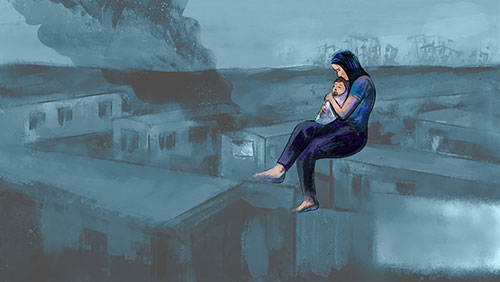
(Dan Carino for LAist)
OILDALE: ‘THEY COULD HAVE JUST FIXED EVERYTHING’
On a 102-degree afternoon last June, baby Jenica’s mother, Marissa Rodriguez, and her sister, Angelica, walked into a conference room in Bakersfield to talk with KPCC/LAist reporters. Angelica brought her 10-month-old son, Marco, who burped, coughed and squealed throughout the interview.
Angelica, the older sister, is more outgoing. She took the lead, detailing their family history and the events that led them to 4J’s Trailer Park in Oildale in 2015. They had been looking for a little more space and the opportunity to live together.
Marissa Rodriguez said her daughter, Jenica, had been “quiet, like me.” During their brief time together, they formed a strong bond. “I didn’t really worry about nothing because I always had her.”
Rodriguez brought a pink box with her that day. “These are her ashes,” she said. “I take her everywhere with me.”
After the fire, Marissa, Angelica and Jenica's father sued Nijjar Realty and PAMA Management. It was an attempt at justice. The complaint alleged that the lack of heating, faulty wiring and absence of smoke and carbon monoxide detectors “created an unreasonable risk of a fire which could cause serious injury and death.” They charged that PAMA and Nijjar Realty's negligence caused Jenica's death.
The Rodriguez sisters’ attorney, Jim Pocrass, told KPCC/LAist that PAMA’s byzantine business structure proved difficult to untangle. “We spent a lot of time trying to ferret through the legal morass of how many different corporations and different ways that [Nijjar] was trying to insulate himself from liability,” he said.
Pocrass said he was shocked by Nijjar’s business practices.
“If there was ever a definition of a slumlord, okay, this guy fit the definition,” he said. “There was preying upon the people that could least afford any kind of housing, and overcharging them for what they were getting, and then giving them nothing.”
The case settled in 2017 for a sum they agreed not to disclose. PAMA’s attorney said her clients denied liability.
Rodriguez didn’t know much about PAMA and Mike Nijjar before the lawsuit. “I just thought it was some guy that owned a place,” she said.
By last summer, Rodriguez was 20 and considering college. At the time of the interview, she had a job picking carrots at a farm outside Bakersfield. She takes pride in her work. “Everything you guys eat, we pick it out,” she said.
After Jenica died, Rodriguez said she stayed in her room for months, crying. She went to therapy, but she still grieves.
“I’m like doing a little better, but it still hurts me,” she said, sniffling and fighting back tears. “I lost my daughter. They could have just fixed everything,” she said. “They should get locked up for it.”
. . .
Additional reporting by Rina Palta, Chava Sanchez, Shana Daloria and Priska Neely. Special thanks to Chris Worthington of APM Reports.
Support for this project came from the Corporation for Public Broadcasting.
This story is the first installment in a new, ongoing series, STUCK: Inside California's Housing Crisis. LEARN MORE
The series was conceived as a way to bring deeply reported, meaningful and recurring coverage about two of California's most pressing issues: the housing crisis and homelessness.
As the state's affordable housing shortage worsens, more and more people find themselves on the brink of homelessness, or in the streets. Last year, more than 151,000 people in California were counted as homeless, a 17% increase since 2018, according to the U.S. Department of Housing and Urban Development.
We're committed to exploring the many corners of this crisis, from the rise of corporate landlords to renters enduring dangerous and illegal conditions to newly arrived immigrants trying to keep a roof over their heads. We'll also explore ways city and state officials have failed to protect vulnerable populations from exploitation and the way many homeless people are relegated to premature death on the streets. Stay tuned for more coverage from STUCK. SHOW LESS
This story was reported through dozens of interviews, thousands of pages of public documents and court records and the analysis of gigabytes of public data.
PAMA Properties
Figures regarding parcels, assessed property values and estimated number of units were reported using data from county assessors. KPCC/LAist analyzed property records known as “secured rolls” from Los Angeles, San Bernardino, Riverside, Kern and Sacramento counties. The number of parcels in those counties is a count of properties owned under names tied to Mike Nijjar and PAMA-affiliated entities, or with a mailing address of PAMA’s El Monte headquarters.
The total property value reflects the combined land and improvement values of those parcels. The estimated number of units reflects the number of units either listed in the data or an estimate based on the “use code” of the parcel, which can indicate a range of units (e.g. 5-10 units). In the latter cases, we used conservative estimates and took the lesser number.
The 16,000 figure in our reporting is an estimate which includes properties across the five California counties in addition to 224 units at a building in Texas. The estimated number of units is less than what PAMA has described in recent job postings, which state that the company “own[s] and manage[s] over 18,000 [u]nits.”
Parcel boundaries were mapped using publicly available GIS data. Properties that claimed a homeowner's exemption in the most recent year analyzed, per the data, were excluded from the map.
Los Angeles County data was obtained in August 2019, San Bernardino County data in July 2019, Riverside County data in December 2019, and Kern and Sacramento counties’ data in April 2019. Issues, such as errors in the data and the dates, mean the map is not an exhaustive picture of properties connected to PAMA Management. In some cases, ownership may have changed since the data was reviewed.
KPCC/LAist also reviewed property information from the Fresno County Assessor but did not include it in the story, due to constraints of the available data.
KPCC/LAist identified what census tract each parcel is in, and analyzed the quartile of median household income of each tract relative to the county it sits in. That allowed us to report that most properties connected to Nijjar are in the poor areas of the counties in which they’re located.
PAMA-Affiliated Entities
The number of PAMA-affiliated entities is a count of active corporations, limited partnerships and limited liability corporations from the California Secretary of State’s data obtained in April 2019. Entities were tied to the Nijjar family and PAMA Management through an analysis of names and mailing addresses in the database. The count doesn’t capture several new corporations connected to PAMA that were created after we received the data in 2019, many of them based in Nevada.
Evictions
The number of eviction lockouts is based on data from Los Angeles and San Bernardino counties spanning 2010-18. Lockouts are the last step of the eviction process, where a sheriff visits a property to return possession to the owner. Our analysis was conservative: It didn’t attempt to quantify other steps in the eviction process, or to account for the substantial number of informal evictions that do not go through the court system.
The data was obtained from county sheriff’s departments, who perform the lockouts.
KPCC/LAist also reviewed lockouts in Riverside and Kern counties, but due to limitations with the data provided, they weren’t factored into the figures in the story.
Only the San Bernardino Sheriff’s Department provided the names of plaintiffs in unlawful detainer cases, which were used to identify PAMA-connected evictions. In Los Angeles County, KPCC/LAist searched for lockouts by address, and checked to make sure the lockout happened when an entity connected to Nijjar owned the property.